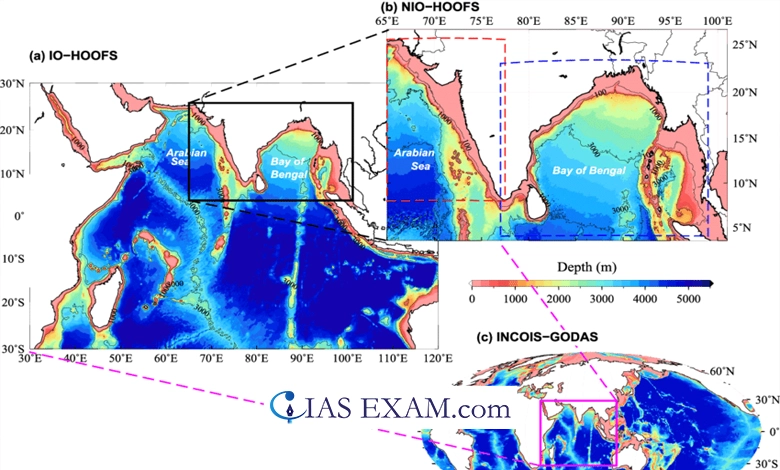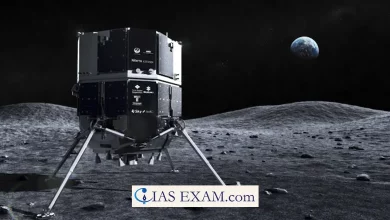
Context
Recently, a study of the Indian Ocean floor or the bathymetry was undertaken by scientists of the Indian National Centre for Ocean Information Services (INCOIS).
Key Highlights
- The study– ‘Impact of bathymetry on Indian Ocean flow in a regional ocean model’ highlights the significance of bathymetry in ocean models to understand ocean actions higher.
- This knowledge is crucial for improving forecasts related to ocean conditions, weather, and climate, specially for Indian ocean rim countries and the subcontinent.
Bathymetry
- It is the observation and mapping of the intensity of water in oceans, rivers, lakes, and streams.
- Bathymetric maps are similar to topographic maps, which use traces to expose the form and elevation of land features. On bathymetric maps, the traces connect points of the same depth.
- Bathymetry is the foundation of the technological know-how of hydrography, which measures the bodily functions of a water frame.
- Hydrography consists of not handiest bathymetry, but also the shape and functions of the shoreline; the characteristics of tides, currents, and waves; and the physical and chemical properties of the water itself.
Indian National Centre for Ocean Information Services (INCOIS)
- INCOIS is an autonomous organisation of the Government of India.
- It gives ocean records and advisory offerings to the medical community, industry, government organisation, and society.
- INCOIS is a unit of the Earth System Science Organization (ESSO) and was established in 1999 under the Ministry of Earth Sciences (MoES).
- It is located in Hyderabad.
Key highlights of the study
- The Contrasting Currents of the Indian Ocean
-
-
- The Indian Ocean’s currents are not completely governed by surface influences.
- The study indicates that each the Andaman and Nicobar Islands and the Maldives islands play central roles in changing the direction and velocity of these currents, in particular in the deep ocean.
- Interestingly, those submerged dynamics often contradict the moves located at the ocean’s surface, revealing a complicated interplay between diverse oceanic forces.
-
- Revolutionizing Ocean Modeling: Correcting Coastal Currents Around India
-
-
- The study discovered massive discrepancies in formerly employed ocean modeling systems, particularly of their representation of coastal currents around India.
- Through comprehensive bathymetry research, other developments were executed in correctly depicting main ocean characteristics such as salinity, temperature, and currents, specifically in coastal areas.
- A more practical East India Coastal Current (EICC) moving with the flow was envisioned at 1,000 metres and 2,000 metres depth, that is opposite to that of the surface.
-
- Insights from Andaman, Nicobar, and Maldives
-
-
- The study exposed a massive boundary present day tracing the coast of the Andaman and Nicobar Islands at a depth of two,000 meters, losing light on formerly unrecognized deep-sea dynamics.
- Moreover, the presence of the Maldives Islands emerges as a key thing in extending the Equatorial Under Current (EUC)
- EUC is a strong, narrow, eastward-flowing current that’s located in the upper thermocline, centered on the equator.
- It’s a permanent function of the Atlantic and Pacific oceans, and is also present in the Indian Ocean for the duration of the northeast monsoon in the spring and wintry climate.
- Notably, seasonal versions in the EUC’s traits had been diagnosed, with a more described structure discovered all through the fall months in the jap Equatorial Indian Ocean, at depths ranging from 50 to 100 meters.
- However, in spring, it’s a bit deeper, around 100 to 150 meters.
-
- The Crucial Role of Ocean Forecasting in Weather, Climate, and Industry
-
- Oceans substantially have an impact on weather, climate, and the maritime quarter.
- This highlights the need for precise forecasts of oceanographic parameters like currents, temperature, and salinity across diverse time frames.
- Achieving correct predictions is based on reinforced observations and refined modeling techniques, critical for assisting each economic activity and scientific understanding.
Source: The Hindu
UPSC Mains Practice Questions
Q.Discuss the relief of the bathymetry. Also mention the factors that affect salinity distribution in the oceans. (250 Words)





.png)



